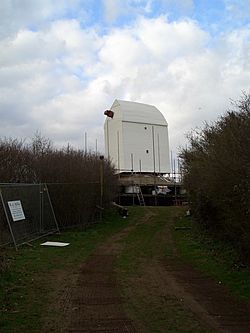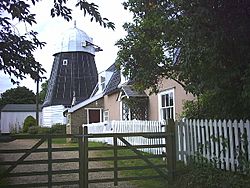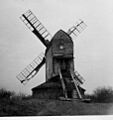Drinkstone windmills facts for kids
Quick facts for kids Drinkstone Post Mill |
|
|---|---|

Drinkstone post mill
|
|
| Origin | |
| Mill name | Clover's Mill |
| Grid reference | TL 964 622 |
| Coordinates | 52°13′24″N 0°52′29″E / 52.2234°N 0.8747°E |
| Operator(s) | Private |
| Year built | 1689 |
| Information | |
| Purpose | Corn mill |
| Type | Post mill |
| Roundhouse storeys | Single storey roundhouse |
| No. of sails | Four sails |
| Type of sails | Two Spring sails, two Common sails |
| Windshaft | Wood, with cast iron poll end |
| Winding | Fantail |
| No. of pairs of millstones | Two pairs |
| Drinkstone Smock Mill | |
|---|---|

Drinkstone smock mill
|
|
| Origin | |
| Mill name | Clover's Mill |
| Grid reference | TL 962 622 |
| Operator(s) | Private |
| Year built | 1780 |
| Information | |
| Purpose | Corn mill |
| Type | Smock mill |
| Storeys | Two-storey smock |
| Base storeys | single-storey base |
| Smock sides | Eight sides |
| No. of sails | Four sails |
| Type of sails | Two Spring sails and two Common sails |
| Windshaft | Wood |
| Winding | Fantail |
| Other information | Base formerly a horse mill |
The Drinkstone Windmills are a special pair of windmills found in Drinkstone, Suffolk, England. They are unique because they include two different types of windmills: a post mill and a smock mill. These mills were very important for grinding corn into flour.
For a long time, these mills were known as Clover's Mills. This was because the Clover family owned and operated them for many generations. The post mill is a very old and important building, listed as Grade I, while the smock mill is also historically significant, listed as Grade II*.
The Post Mill
The Drinkstone Post Mill was first built as an open trestle post mill. This means its main body, which holds all the machinery, could turn around on a central post. This allowed the mill to face the wind.
In 1830, a roundhouse made of brick and flint was added around the base. This protected the trestle from the weather. The mill originally used simple 'Common sails'. Later, 'Spring sails' were added, which could adjust to the wind more easily. Eventually, it worked with a mix of both types of sails.
The mill has a wooden shaft that connects the sails to the gears inside. This shaft was later fitted with a cast iron 'poll end' by a mill builder named C Sillitoe. In the 1920s, an 'air brake' was tried on the sails, but it didn't work well.
At first, the mill was turned to face the wind using a long 'tailpole'. But in the 1940s, a 'fantail' system was added. A fantail is a small windmill at the back that automatically turns the main mill into the wind. Parts for this fantail came from other mills, like Barley Green Mill and Thurston Mill. The fantail from Woolpit Mill was added in 1963.
The wooden frame of the mill shows how old it is. The main body has been extended over time. The mill has two pairs of millstones for grinding grain. Today, this historic mill is on the 'Heritage at Risk Register', meaning it needs care to stay standing.
Post Mill History
The Drinkstone Post Mill was built in 1689. This makes it the oldest windmill in all of Suffolk!
The Clover family played a big role in its history. Samuel Clover was given the post mill, a horse mill, and the mill house by his father in 1775. The mill then passed down through many generations of the Clover family.
In 1947, Wilfred Clover took over the mill. However, on February 28, 1949, a strong tailwind damaged the sails and fantail. The mill stopped working and became run-down. But in 1962, Mr. Clover bravely restored it and got it working again!
The Smock Mill
The Drinkstone Smock Mill was built in 1780. It was built on top of an older horse mill that had been there since 1689. A horse mill used horses to power its grinding stones.
This mill is a 'smock mill', which means its body looks a bit like a farmer's smock (a loose shirt). It has an eight-sided, two-storey wooden tower sitting on a single-storey base. The base is where the old horse mill used to be.
The top of the mill has a 'pepperpot cap'. This cap, which holds the sails, used to be turned by a chain and wheel. Later, a 'fantail' was added to automatically turn the cap into the wind, just like on the post mill.
The smock mill also used a mix of 'Common sails' and 'Spring sails'. It had a wooden shaft to transfer power from the sails. The heavy millstones inside were supported on a special frame called a 'hurst frame'. This type of frame is often found in watermills, making it a unique feature for a windmill.
Windmills in Pop Culture
The Drinkstone Post Mill is famous for appearing in an episode of the classic British TV show, Dad's Army. In the episode "Don't Forget the Diver", the character Lance Corporal Jones had a funny scene where he rode around on the sails of the mill and was then thrown into a pond!
Images for kids


